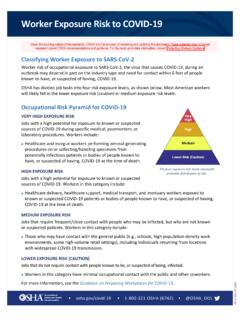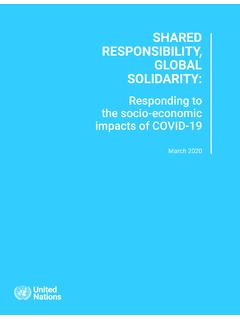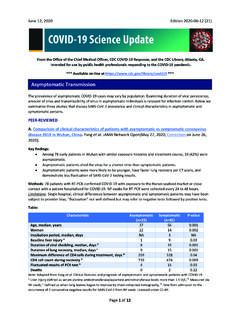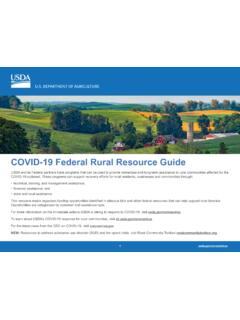Transcription of COVID-19 Emergency Declaration Blanket Waivers for …
1 Updated 5/24/21 1 COVID-19 Emergency Declaration Blanket Waivers for Health Care Providers The Administration is taking aggressive actions and exercising regulatory flexibilities to help healthcare providers contain the spread of 2019 Novel Coronavirus Disease ( COVID-19 ) . CMS i s empowered to take proactive steps through 1135 Waivers as well as, where applicable, authority granted under section 1812(f) of the Social Security Act (the Act) and rapidly expand the Administration s aggressive efforts against COVID-19 . As a result, the following Blanket Waivers are in effect, with a retroactive effective date of March 1, 2020 through the end of the Emergency Declaration .
2 For general information about Waivers , see Attachment A to this document. These Waivers DO NOT require a request to be sent to the 1135waive mailbox or that notification be made to any of CMS s regional offices. Flexibility for Medicare Telehealth Services Eligible Practitioners. Pursuant to authority granted under the Coronavirus Aid, Relief, and Economic Security Act (CARES Act) that broadens the waiver authority under section 1135 of the Social Security Act, the Secretary has authorized additional telehealth Waivers . CMS i s wai vi ng the re qui re me nts of se cti on 1834( m) ( 4) ( E) of the Act and 42 CFR ( b) ( 2) whi ch specify the types of practitioners that may bill for their services when furnished as Medicare telehealth services from the distant site.
3 The waiver of these requirements expands the types of health care professionals that can furnish distant site telehealth services to include all those that are eligible to bill Medicare for their professional services. This allows health care professionals who were previously ineligible to furnish and bill for Medicare telehealth services, including physical therapists, occupational therapists, speech language pathologists, and others, to receive payment for Medicare telehealth services. Audio-Only Telehealth for Certain Services. Pursuant to authority granted under the CARES Act, CMS is waiving the requirements of section 1834(m)(1) of the ACT and 42 CFR (a)(3) for use of interactive telecommunications systems to furnish telehealth services, to the extent they require use of video technology, for certain services.
4 This waiver allows the use of audio-only equipment to furnish services described by the codes for audio-only telephone evaluation and management services, and behavioral health counseling and educational services (see designated codes ). Unless provided otherwise, other services included on the Medicare telehealth services list must be furnished using, at a minimum, audio and video equipment permitting two-way, real-time interactive communication between the patient and distant site physician or practitioner. Updated 5/24/21 2 Hospitals, Psychiatric Hospitals, and Critical Access Hospitals (CAHs), including Cancer Centers and Long-Term Care Hospitals (LTCHs) Emergency Medical Treatment & Labor Act (EMTALA).
5 CMS is waiving the enforcement of section 1867(a) of the Act. This will allow hospitals, psychiatric hospitals, and critical access hospitals (CAHs) to screen patients at a location offsite from the hospital s campus to prevent the spread of COVID-19 , so long as it is not inconsistent with a state s Emergency preparedness or pandemic plan. Verbal Orders. CMS i s wai vi ng the re qui re me nts of 42 CFR , and ( d) ( 3) to provide additional flexibility related to verbal orders where read- back verification is required, but authentication may occur later than 48 hours. This will allow more efficient treatment of patients in surge situations. Specifically, the following requirements are waived: o ( c) ( 3) ( i ) - If verbal orders are used for the use of drugs and biologicals (except immunizations), they are to be used infrequently.
6 O ( c) ( 2) - All orders, including verbal orders, must be dated, timed, and authenticated promptly by the ordering practitioner or by another practitioner who is responsible for the care of the patient. o ( c) ( 3) - Hospitals may use pre-printed and electronic standing orders, order sets, and protocols for patient orders. This would include all subparts at (c)(3). o ( d) ( 3) - Although the regulation requires that medication administration be based on a written, signed order, this does not preclude the CAH from using verbal orders. A practitioner responsible for the care of the patient must authenticate the order in writing as soon as possible after the fact.
7 Reporting Requirements. CMS is waiving the requirements at 42 CFR (g) (1)(i)-(ii), which require that hospitals report patients in an intensive care unit whose death is caused by their disease, but who required soft wrist restraints to prevent pulling tubes/IVs, no later than the close of business on the next business day. Due to current hospital surge, CMS is waiving this requirement to ensure that hospitals are focusing on increased patient care demands and increased patient census, provided any death where the restraint may have contributed is still reported within standard time limits ( , close of business on the next business day following knowledge of the patient s death).
8 Patient Rights. CMS i s wai vi ng re qui re me nts unde r 42 CFR only for hospitals that are considered to be impacted by a widespread outbreak of COVID-19 . Hospitals that are located in a state which has widespread confirmed cases ( , 51 or more confirmed cases*) as updated on the CDC website, CDC States Reporting Cases of COVID-19 , at ases- , would not be required to meet the following requirements: Updated 5/24/21 3 o (d)(2) - With respect to timeframes in providing a copy of a medical record. o ( h) - Related to patient visitation, including the requirement to have written policies and procedures on visitation of patients who are in COVID-19 isolation and quarantine processes.
9 O (e)(1)(ii) - Regarding seclusion. *The waiver flexibility is based on the number of confirmed cases as reported by CDC and will be assessed accordingly when COVID-19 confirmed cases decrease. Sterile Compounding. CMS is waiving requirements (also outline d i n USP797) at 42 CFR ( b) ( 1) and ( a) ( 3) i n orde r to al l ow use d f ace masks to be re move d and retained in the compounding area to be re-donned and reused during the same work shift in the compounding area only. This will conserve scarce face mask supplies. CMS will not review the use and storage of face masks under these requirements. Detailed Information Sharing for Discharge Planning for Hospitals and CAHs.
10 CMS is waiving the requirement 42 CFR ( a) ( 8) , ( e ) , and ( a) ( 8) to provide detailed information regarding discharge planning, described below: o The hospital, psychiatric hospital, and CAH must assist patients, their families, or the patient s representative in selecting a post-acute care provider by using and sharing data that includes, but is not limited to, home health agency (HHA), skilled nursing facility (SNF), inpatient rehabilitation facility (IRF), and long-term care hospital (LTCH) quality measures and resource use measures. The hospital must ensure that the post-acute care data on quality measures and resource use measures is relevant and applicable to the patient s goals of care and treatment preferences.















